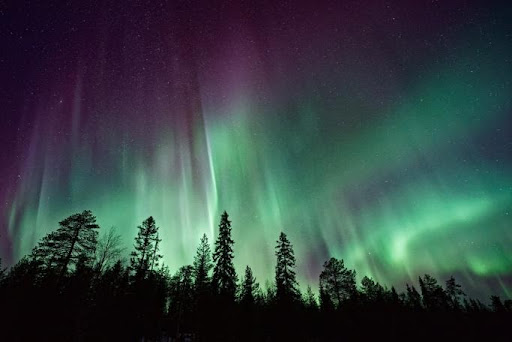Aurora (Southern Lights): What Is It & The Definition
Many travelers know about the Northern Lights and want to see them. However, many do not realize that there are Southern Lights too. These lights may not be as popular, but they are just as beautiful. The lights in the Southern Hemisphere are called the Aurora Australis.
This post has everything you need to know about the Aurora Australis, so make sure to share it with friends and family who also want to learn about these beautiful Southern Lights.
An aurora also goes by the names Aurora Polaris or Polar Lights. This natural light display happens in high-latitude regions like Antarctica and the Arctic. The aurora has captured the hearts of many with the beautiful lights appearing as spirals, rays, dynamic flickers, and curtains that cover the entire sky.
Additionally, the word ‘Aurora’ comes from Aurora, the Roman goddess of the dawn. Ancient Greek literature would often say that morning had an assortment of colors across the dark sky. That is why the term aurora is used today for the Northern and Southern Lights.
Origin of Aurora (Southern Lights)
The aurora happens when there are disturbances to the magnetosphere because of the solar winds. Additionally, the particles that make their way into the magnetosphere mix with the plasma found, which results in them illuminating and emitting various light colors. Moreover, the form of the aurora depends on how fast the particles travel.
What Causes the Formation of Aurora (Southern Lights)?
Auroral Particles
The Sun spews out charged particles that make their way towards Earth. Some of them do not make it through the atmosphere, but some charged particles can break through the magnetic atmosphere around the Earth. When this happens, these particles manage to go along the Earth’s magnetic field toward the polar regions.
Once the particles make their way through the atmosphere, they release colorful protons that end up lighting up the sky with colors.
Atmosphere
Earth has a magnetic field around it while having a bar magnet running from the North Pole to the South Pole. The field creates lines that curve outward from both poles and stretch beyond the atmosphere. This is called a magnetosphere. Its job is to keep charged particles released by the Sun away from Earth.
However, when the particles manage to break through, they mix with photons released from the Earth’s upper atmosphere. After this happens, the auroras occur.
Ionosphere
When there are bright auroras, it means they’ve traveled down into the ionosphere on one side of the pole and out the other side. Inside the ionosphere, the solar winds come crashing with atoms made of nitrogen and oxygen. This releases energy that causes the colorful glowing halo that can be found around the poles when there is an aurora.
Occurrence and Characteristics of Aurora (Southern Lights) in the Form of:
Images
The earliest piece of imagery that could catch either aurora was completed in 1949 by the University of Saskatchewan.
Forms
Four primary forms of the aurora that are typically seen are:
- A mild shine near the horizon. This can be close to the limited range of vision, but it is distinguishable from the light that the moon gives off.
- Surfaces or patches that resemble clouds.
- When you see arcs bend across the sky.
- Multiple rays of light that are dark and light stripes that go across the arcs to reach upwards.
- Multiple coronas across the sky spread out from one point.
Additionally, onlookers have said that the aurora can also appear as curtains, but this can be seen when it has formed arcs.
Colors and Wavelength

- Red: Red appears at the aurora’s highest altitude. This can only be seen when there is intense solar activity. That is why it can usually be seen at the very top of the aurora and appears as a faint red color.
- Green: Many onlookers see green when the aurora appears because this part has a high concentration of atomic oxygen. The molecular nitrogen that crashes into the oxygen atom gives off a green color. The red and green colors sometimes mix and create yellow or pink hues.
- Blue: People tend to see the blue colors of the aurora at the lower edges of the curtains. There is less atomic oxygen at lower altitudes, so the ionized molecular nitrogen and molecular nitrogen take over the radiating light. Blue ends up being the stronger light in this section of the aurora.
- Ultraviolet: Everyone cannot see this but is typically seen within an optical window using the appropriate equipment. Ultraviolet auroras have also been seen on Jupiter, Mars, and Saturn.
- Infrared: The infrared colors can also be seen during an optical window using the appropriate equipment.
Difference Between Aurora (Southern Lights) and Aurora (Northern Lights)
There is no real difference between the Southern Lights and the Northern Lights. The main differences are that they have different names and happen in other places in the world. Additionally, the Southern Lights have intense spots at dusk in the winter months, while the Northern Lights have intense spots at dawn during the summer months.
The Northern Lights are more popular because there are more places where people can go and see them, like Canada, Greenland, Alaska, Russia, and Norway. However, the places in the Southern Hemisphere to go and see the Southern Lights are limited.
What Is the Best Time to See Aurora Lights?
Like the Northern Lights, the Southern Lights are just as challenging to predict when they will appear. However, some websites allow you to see an hourly forecast based on the solar wind data. This data can help determine the likelihood of the Southern Lights to make an appearance.
However, it’s important to note that the best time to see the Southern Lights is during the fall and winter. That means it is best to look for them from September through to March.
Best Places to See the Aurora (Southern Lights)
There are four great places to go and view the Aurora Australis:
- Queenstown, New Zeeland
- Mount Wellington, Tasmania
- Victoria, Australia
- Antarctica & South Georgie Island
Facts About Aurora (Southern Lights)
- The aurora makes a crackling noise, and it can be heard 230 feet above the Earth’s surface.
- Green is the most common aurora color.
- Southern Lights are the brightest in the South Pole.
Conclusion

The Southern Lights are breathtakingly beautiful and loved by those who have seen them. Even though they are not as popular as the Northern Lights, they are still produced in the same way. Additionally, if you want to see them, you will need to travel pretty far down south during the winter to try and catch a glimpse of these lights.
If this post was helpful to you, remember to share it with friends and family who also want to learn about the Southern Lights.
FAQs About Aurora (Southern Lights)
What Are Southern Lights or Northern Lights?
The Southern and Northern Lights are incredible displays of light that are colorful. They have different names according to which set of lights you refer to; the Southern Lights are called the Aurora Australis, and the Northern Lights are called the Aurora Borealis.
Does the South Pole Have Southern Lights?
Yes, the Southern Lights appear in the sky above the South Pole.
Why Are There No Auroras in the South Pole?
Contrary to popular belief, the Southern Lights are visible from the South Pole. People assume that the Southern Lights cannot be seen in this area because not as many people have seen them there.
The Northern Lights can be easily seen by millions of people every year because they can be seen in North America, Europe, and Asia. However, the Southern Lights can only be seen in a few parts of Australia, New Zealand, and the South Pole.

Casper Henson
